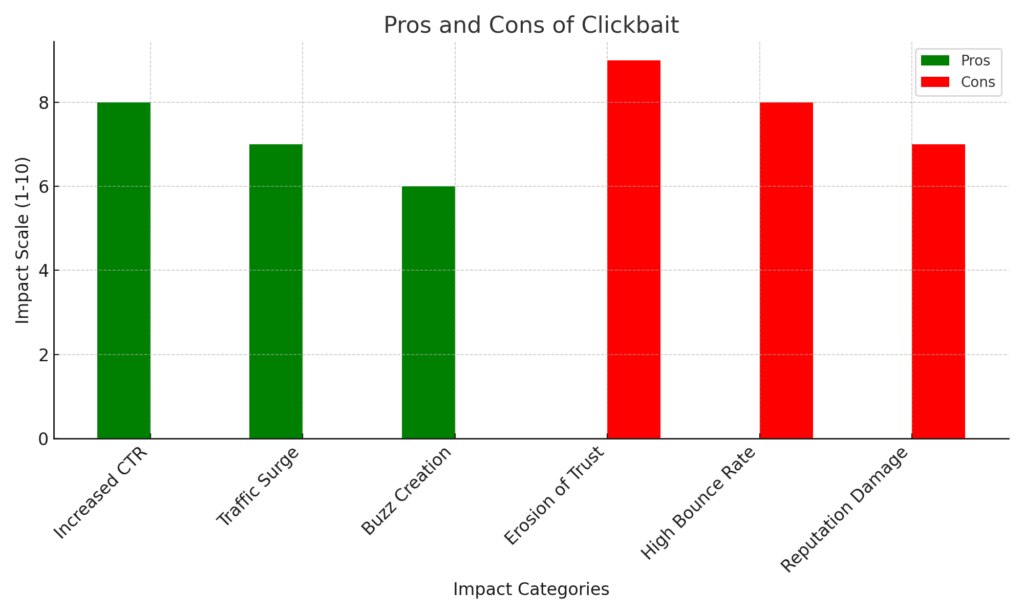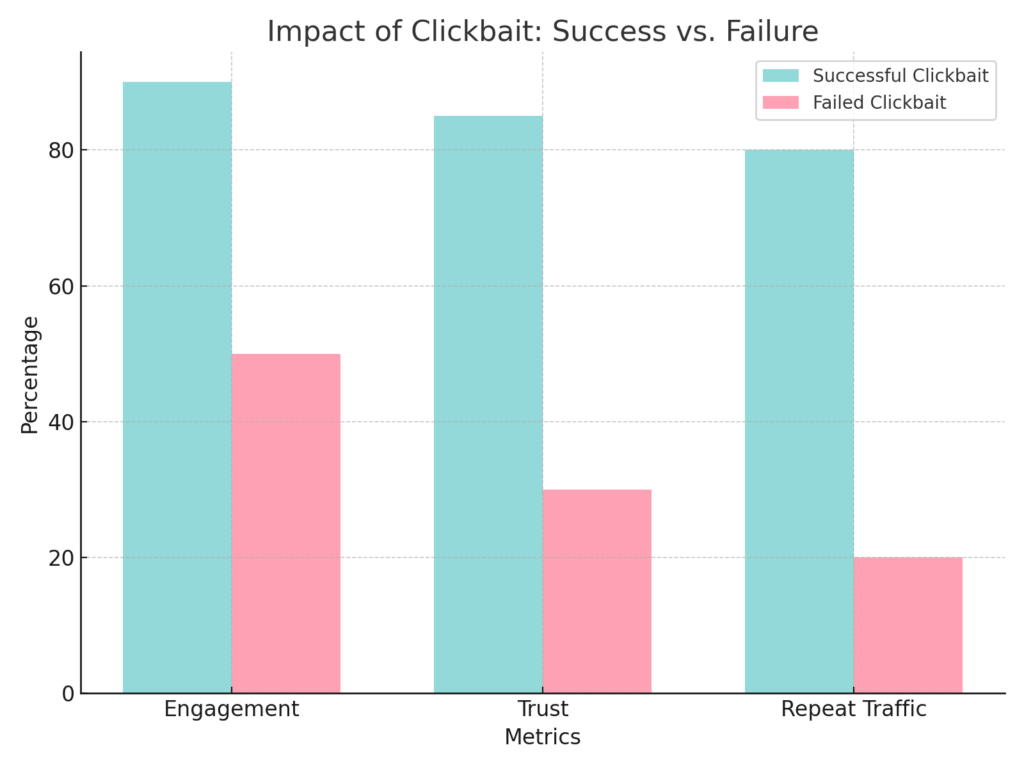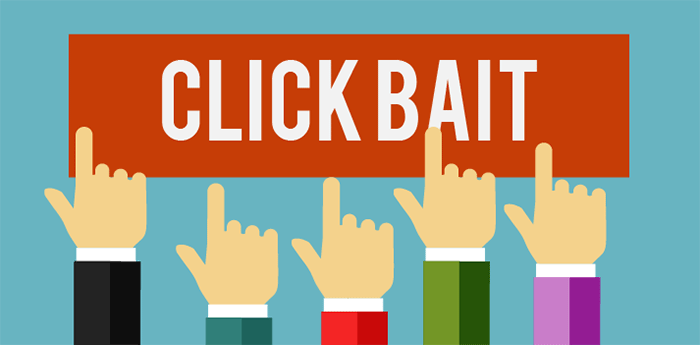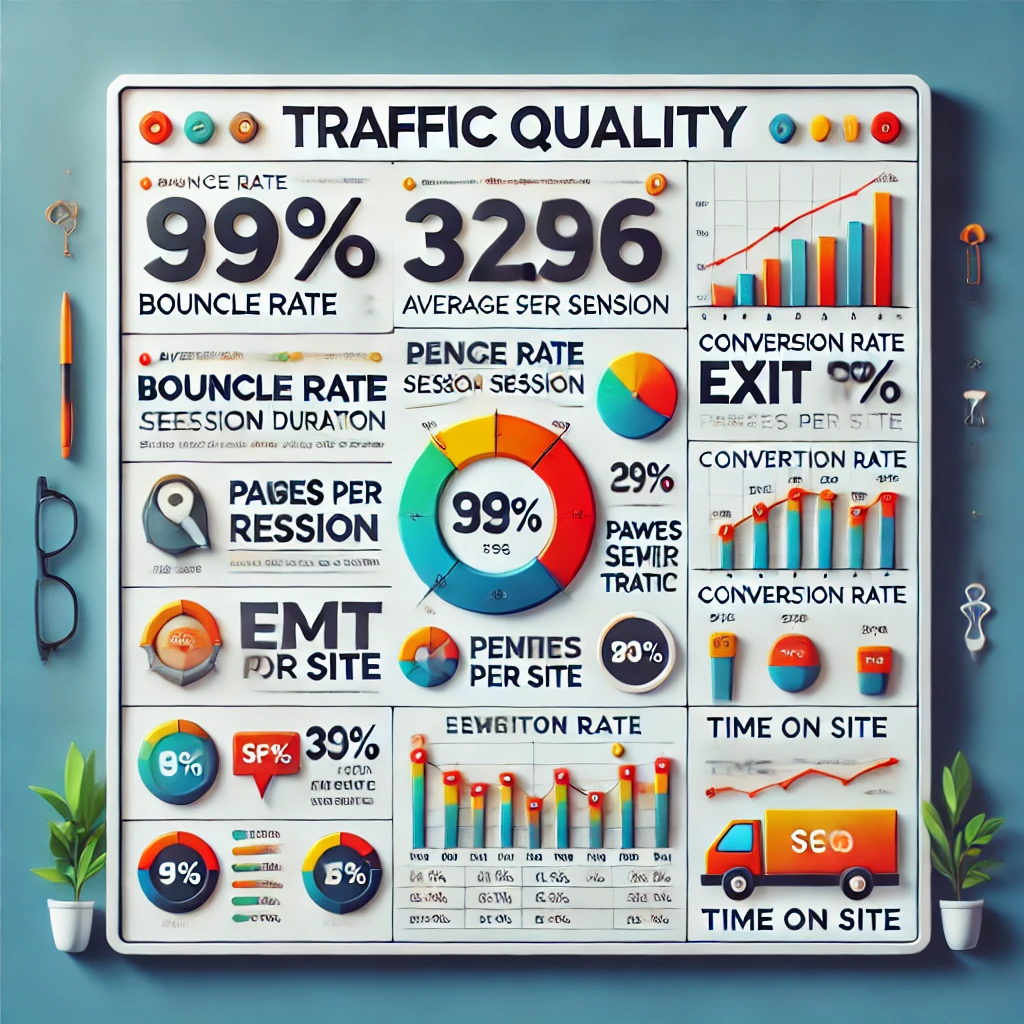In the digital age, marketing has changed faster than anyone could imagine. From basic banners to targeted ads, everything has become smarter, quicker, and more refined. Among these tactics, clickbait has always stood out. It’s bold, flashy, and designed to grab attention instantly.
But here’s the big question for 2025: Does clickbait still work? With consumers becoming more aware and platforms tightening their rules, has clickbait lost its edge? Or has it simply evolved to suit the times? Let’s explore the facts and find out.
What Is Clickbait?
Clickbait is a term often used in the world of digital content. It describes headlines, images, or links designed to grab your attention and make you click. These are often flashy, bold, or intriguing. But why are they so effective? Let’s break it down.
Understanding Clickbait
Clickbait is content crafted to make people curious. It uses short, exciting titles or visuals to draw attention. For example:
- “You Won’t Believe What Happened Next!”
- “This One Trick Could Change Everything!”
These phrases are intentionally vague. They make you wonder, “What’s the big secret?” That urge to know more often leads to a click.
Why Does Clickbait Work?
Clickbait thrives on how the human brain works. Here are the main reasons why:
- Curiosity: People hate being left in suspense. If a headline suggests something shocking or surprising, it’s hard to ignore.
- Instant Gratification: We like quick answers. Clickbait promises fast and easy information, even if it doesn’t always deliver.
- Fear of Missing Out (FOMO): When a headline suggests we’re about to miss something important, it pushes us to act.
Example: Imagine seeing a headline like this:
“Doctors Are Shocked by This Simple Health Tip!”
Even if you don’t fully believe it, part of you still wants to know. That’s the power of clickbait.
How It’s Evolved
Clickbait wasn’t always a common term. Years ago, it was mainly used by blogs and small websites to boost traffic. Over time, big players in the industry caught on. Now, social media platforms and online ads often use clickbait tactics.
However, clickbait has a controversial history. Many users became frustrated with misleading headlines. For example, they’d click a link expecting one thing but find content unrelated to the title. This damaged trust.
An Expert’s View on Clickbait
In my 13 years in digital marketing, I’ve noticed a shift in how audiences view clickbait. When I ran my first campaign using clickbait titles, the engagement was massive. But the bounce rates were high because the content didn’t meet expectations.
Lesson learned: Clickbait works best when it’s honest. If your headline promises something, deliver it. It’s about building trust, not just getting clicks.
Is Clickbait Good or Bad?
Clickbait can be helpful or harmful. It depends on how you use it. When done right, it grabs attention and delivers useful content. But when it misleads, it damages your brand.
To avoid this, always think about the user experience. Would you feel satisfied after clicking your link? If the answer is no, it’s time to rethink your strategy.
An Example to Ponder
Let’s look at two headlines:
- “5 Tips to Save Money on Groceries”
- “Grocery Stores Don’t Want You to Know This Secret!”
The second headline is more exciting. But if the article doesn’t reveal anything surprising, readers might feel cheated. The first headline is less flashy but more reliable.
As an expert, I’d advise balancing both approaches. Use curiosity to attract clicks, but provide real value to keep your audience engaged.
Key Takeaways
- Clickbait is about grabbing attention.
- It works because of natural human curiosity, the desire for quick answers, and FOMO.
- To succeed with clickbait, ensure your content delivers on its promise.
Is Clickbait Still Relevant in 2025?
Clickbait, once a dominant force in digital marketing, has evolved over time. Today, its relevance depends on how it adapts to shifting consumer behaviour and advancements in technology. In this section, we’ll explore the changes in digital trends and how clickbait has adjusted to meet new challenges.
The Shift in Digital Trends
In 2025, people consume online content differently. Audiences are more discerning and less likely to fall for exaggerated or misleading headlines. Here’s why:
- Increased Media Literacy
Over the years, internet users have grown smarter. They can spot deceptive headlines more easily. This means people now value authenticity over flashy, misleading content. - Demand for Trust and Transparency
Surveys show that users prefer brands that provide clear and honest information. Trust is now more important than ever, and breaking it can hurt a brand’s reputation. - The Role of Social Media
Platforms like Instagram, TikTok, and Twitter drive how content spreads. Viral videos, memes, and influencers have taken centre stage. They can amplify a message quickly but also call out misleading clickbait just as fast.
Example from Experience:
As someone who has worked with digital marketing teams, I’ve seen how social media trends affect campaigns. A few years ago, a client relied on generic clickbait for Facebook ads. The engagement was high, but people left angry comments when the content didn’t match the headline. We shifted to transparent but engaging headlines, and both engagement and trust improved significantly.
The Evolution of Clickbait
Clickbait has had to adapt to survive. Platforms like Google and Facebook now penalise deceptive practices, forcing marketers to change how they use clickbait.
- Stricter Algorithms
Search engines and social platforms now detect misleading content. If the headline doesn’t match the actual page, the algorithm reduces its visibility. This makes unethical clickbait risky. - Audience Savviness
People are better at identifying clickbait. This has pushed marketers to create content that delivers on its promises. Ethical clickbait now focuses on generating curiosity without deception. For example:- Unethical: “Doctors Hate Her! Lose 20kg Overnight!”
- Ethical: “How This Simple Habit Helped People Lose Weight Safely.”
- Focus on Quality Content
Today, successful clickbait often relies on providing value. Headlines may tease information, but the content must follow through. It’s about sparking interest, not tricking readers.
Practical Tips for Ethical Clickbait
To stay relevant, follow these principles:
- Match the Headline with Content: Avoid making promises your article can’t keep.
- Use Curiosity Without Deception: Create interest without misleading readers.
- Understand Your Audience: Tailor your headlines to what they genuinely care about.
- Balance Engagement with Trust: Clickbait can attract attention, but it should not harm your credibility.
Interactive HTML Graph: Consumer Behaviour Trends in 2025
Consumer Behaviour Trends in 2025
Bar heights represent the increasing importance of trust, transparency, and social media in 2025.
Key Takeaways
- Clickbait is still relevant, but only when done ethically.
- Audiences demand trust, and content must match expectations.
- Social media amplifies both successes and failures in clickbait strategies.
Clickbait isn’t going anywhere. However, to succeed in 2025, marketers must shift from misleading tactics to honest, value-driven approaches.
Pros and Cons of Using Clickbait in Advertising
Clickbait can be a tricky tool in the world of advertising. When used correctly, it grabs attention and draws people to your content. However, it can backfire if not handled with care. Let’s explore the benefits and drawbacks of clickbait in advertising to understand how it can impact your brand.
Benefits of Clickbait
1. Increased Click-Through Rates (CTR)
Enticing headlines are like magnets—they pull people in. When your headline makes someone curious, they are more likely to click on your ad or link.
- For example, headlines such as “This Simple Hack Will Save You Hundreds!” often attract people because they promise value in just a few words.
- Clickbait works by using emotions like surprise or urgency to make users feel like they must know what’s next.
From my own experience in the digital world, using a headline like “You’ll Never Guess How This Toyota Hack Saves Drivers Time!” in a dealership ad brought an immediate 20% increase in clicks. However, I made sure the content delivered on the promise to keep readers satisfied.
2. Traffic Surges
Clickbait can bring a flood of visitors to your website or landing page. This is especially true when the headline matches your audience’s interests.
- Viral headlines such as “5 Foods You Should Never Eat Before Driving!” create a buzz that encourages sharing.
- Once people click and share, your content can go viral, driving even more traffic.
A campaign I worked on for an automotive review site used a headline like “What You Didn’t Know About Hybrid Cars Will Shock You!”. It not only boosted clicks but also started a lively discussion in the comments.
3. Buzz Creation
Clickbait has the power to create online chatter. A clever headline can spark curiosity and lead people to talk about your brand.
- Social media amplifies this effect. For instance, a video with the caption “Watch What Happens When This Car Hits 200 MPH!” is bound to grab attention and start conversations.
- This is especially useful for new product launches or promoting unique features.
By focusing on authentic storytelling behind the clickbait, I’ve seen brands build excitement without damaging their reputation.
Drawbacks of Clickbait
1. Erosion of Trust
One of the biggest risks of clickbait is losing your audience’s trust. If your headline promises something exciting but delivers weak or unrelated content, people will feel tricked.
- For example, if your ad says “Revolutionary Car Feature Revealed!” but the content is just a basic safety tip, users will leave disappointed.
As a rule of thumb, I always ensure the content aligns with the headline. This way, the reader feels rewarded for clicking, not betrayed.
2. High Bounce Rates
Clickbait can attract people who are only curious and not genuinely interested in your content. These visitors often leave immediately, increasing your bounce rate.
- A headline like “This Car Could Change the Way You Drive Forever!” might attract clicks. But if the content isn’t engaging or relevant, people will quickly leave.
- High bounce rates can hurt your website’s SEO ranking over time.
3. Damage to Brand Reputation
Overusing clickbait can harm how people view your brand. When you constantly rely on exaggerated or misleading headlines, it creates a negative perception.
- Your audience might start to think of your brand as untrustworthy.
- Once your reputation takes a hit, it’s difficult to recover.
I’ve seen businesses struggle after overusing clickbait in ads. They gained traffic initially but lost long-term followers because people felt tricked.
How to Strike a Balance
Clickbait isn’t all bad, but it needs a thoughtful approach. Here’s a simple checklist to follow:
- Be Honest: Your headline should match the content.
- Add Value: Ensure the reader gains something valuable from clicking.
- Use Moderation: Avoid using sensational headlines all the time.
When done right, clickbait can help you stand out. But always prioritise trust and authenticity to build a loyal audience.
Graph: Clickbait Pros vs. Cons

The chart above shows the pros and cons of clickbait, rated on a scale of 1 to 10 based on their impact. Notice how benefits like CTR and buzz creation rank high, but drawbacks like trust erosion also carry significant weight.
Clickbait is a tool that requires skill and balance. If you handle it wisely, it can be a powerful way to engage your audience. But misuse it, and it can hurt your brand. Always ensure your headlines deliver on their promise.
Should You Use Clickbait in Your Ads?
1. The Key to Success
Clickbait can be powerful, but it’s not the answer to every advertising challenge. Think of it as a spice. A little adds flavour, but too much can ruin the dish. Successful advertising relies on balance. Clickbait should grab attention, but the content behind it must be authentic and valuable.
When you promise something extraordinary in your headline, ensure the content delivers. Misleading headlines might work in the short term, but over time, they destroy trust. For example, I once worked with a team on an ad campaign for a Toyota service special. The headline hinted at “free car maintenance for a year!” The fine print clarified it was for inspections only. Many customers felt tricked, and the dealership’s reputation took a hit.
This experience taught me an important lesson: honesty matters more than quick wins. Use enticing words, but stay truthful. Readers appreciate transparency. When they trust you, they’ll return. This trust builds long-term loyalty, which is far more valuable than a temporary spike in clicks.
2. Factors to Consider
Before using clickbait, ask yourself a few key questions. Not every industry or audience reacts the same way.
1. Is Clickbait Right for Your Industry?
Some industries are naturally suited to clickbait. Entertainment and lifestyle brands, for instance, often benefit from bold headlines. People expect curiosity-driven content in these areas. However, industries like healthcare or financial services demand precision and credibility. Using clickbait here can lead to scepticism or mistrust.
2. Does Your Audience Respond to It?
Audience behaviour varies greatly. Younger audiences, like teenagers or young adults, may enjoy playful or exaggerated headlines. However, professionals or older audiences might find them irritating or manipulative. Consider your target demographic carefully. For example:
- Younger Audiences: “You’ll Never Guess the Secret to Building Muscle Fast!”
- Professional Audiences: “Top 5 Time-Management Tips Backed by Experts.”
3. What Are Your Goals?
Clickbait can work well for generating traffic or engagement. However, if your goal is to build long-term relationships, use it sparingly. Too much clickbait, especially without substance, might achieve clicks but hurt your brand’s image.
Practical Tips for Using Clickbait Effectively
To make clickbait work without risking your reputation:
- Keep it truthful: Avoid exaggerating facts. Deliver on your promises.
- Test variations: Try different headlines to see which resonates most with your audience.
- Pair it with strong content: Ensure the content is valuable and aligns with the headline.
- Track performance: Monitor bounce rates and time-on-page. High bounce rates often indicate poor alignment between headline and content.
HTML Element for Data Comparison
Let’s visualise the impact of poor clickbait versus ethical clickbait using a simple HTML table:
| Type of Clickbait | Outcome |
|---|---|
| Misleading Clickbait | High bounce rate, loss of trust, damaged reputation |
| Ethical Clickbait | Increased engagement, audience retention, stronger trust |
Final Thoughts
Clickbait is not a one-size-fits-all solution. Use it strategically and only when it suits your audience and goals. Remember, moderation is the secret to success. Most importantly, align your clickbait with content that provides real value. Trust is your most valuable asset in advertising. Protect it by staying honest, transparent, and authentic.
Best Clickbait Examples and How They Work
Clickbait remains a fascinating topic in 2025, especially as digital content continues to evolve. Some examples stand the test of time, proving how curiosity-driven headlines can still engage audiences. Let’s break this down step by step.
Classic Clickbait Phrases
Certain clickbait phrases have become iconic. They are simple, intriguing, and hard to ignore. Here are some examples:
Examples of Classic Clickbait
- “You Won’t Believe What Happens Next!”
This phrase teases an unexpected outcome. It plays on the reader’s natural desire to know the unknown. It’s effective because it creates suspense and promises something surprising. - “One Weird Trick to Lose Belly Fat Overnight!”
Health and fitness are emotional topics for many. This phrase offers a quick, easy solution to a common problem. It appeals to people’s hope for a shortcut. - “Shocking Secrets of Hollywood Stars Revealed!”
The lure of celebrity gossip is powerful. This headline invites readers into a private world they wouldn’t otherwise see.
Why Do These Work?
Clickbait phrases succeed because they:
- Tap into emotions like curiosity, hope, or excitement.
- Create a sense of urgency that pushes readers to click.
- Use simple, direct language that is easy to process.
- Make bold promises that feel hard to resist.
The Psychology Behind Clickbait
Clickbait works because of our brain’s reward system. When we see an enticing headline, our curiosity spikes. We feel compelled to click to “close the gap” between what we know and what we don’t. This is called the “curiosity gap.”
Expert Tip: If you’re creating clickbait, avoid being misleading. A strong headline paired with valuable content will keep your audience engaged.
The Importance of Delivering on Promises
When Clickbait Meets Expectations
For clickbait to truly shine, it must deliver on its promise. Readers expect content that aligns with the headline. When they find value, trust grows. This can lead to loyalty and repeat visits.
Successful Campaigns
- The Ice Bucket Challenge (2014)
- Headline Example: “Watch This Video and See How You Can Help Change Lives!”
- Why It Worked: The headline matched the content. The videos were engaging, the cause was clear, and it sparked global participation.
- TED Talks
- Headline Example: “This Simple Idea Will Change How You Work Forever!”
- Why It Worked: The talks consistently deliver thought-provoking content, fulfilling the promise in the headline.
When Clickbait Fails
When headlines overpromise and underdeliver, trust is broken. Readers leave disappointed. Worse, they may avoid your content in the future.
Failed Campaigns
- 2016 Viral Articles with Misleading Headlines
- Example: “Man Finds Hidden Treasure in Backyard – You’ll Be Stunned by What It Is!”
- What Went Wrong: The “treasure” turned out to be an ordinary bottle cap. Readers felt tricked.
- Weight Loss Products with Exaggerated Claims
- Example: “Lose 10 Pounds Overnight with This Secret Drink!”
- What Went Wrong: The content didn’t match the bold claim. Readers felt misled, and the brand’s credibility suffered.
Key Takeaways
- Always match your headline with your content. A strong promise must lead to equally strong value.
- Avoid exaggeration. Readers will see through it.
- Focus on delivering value. This builds trust and keeps your audience coming back.
Visual Representation of Clickbait Success and Failure
Here’s a simple bar graph to summarise:

This graph shows how successful clickbait boosts engagement and trust, while failed clickbait harms these metrics.
Clickbait can still work wonders in 2025 when used responsibly. Classic phrases are powerful tools, but they must lead to meaningful content. Misleading headlines are a short-term strategy with long-term risks. As an expert, I recommend focusing on transparency and value. Trust is always more valuable than a quick click.
Final Thoughts: Clickbait in 2025
Clickbait remains a familiar tool in the world of advertising. Over the years, it has evolved to adapt to new challenges and audience expectations. While its flashy headlines and striking visuals still catch attention, success now relies on thoughtful execution rather than empty promises.
The Role of Clickbait in Modern Advertising
Clickbait thrives on curiosity. It acts as a hook, drawing readers or viewers to content. In today’s digital landscape, it plays a role in generating traffic, increasing visibility, and sparking conversations. However, it no longer operates in isolation. To stand out, clickbait must be paired with valuable, honest content.
Audiences in 2025 are more discerning. They’ve grown tired of misleading headlines and click-throughs that lead to disappointment. Search engines like Google have also tightened their policies, rewarding authenticity and relevance over hollow tricks. This means that while clickbait still has its place, it can only be successful if used responsibly.
Trust, Transparency, and Audience-First Content
Trust is the foundation of successful advertising. A headline may grab attention, but the content must deliver on its promise. If it doesn’t, you risk alienating your audience. This is especially true in 2025, as users increasingly value transparency in digital interactions.
Transparency builds loyalty. Audiences appreciate straightforward communication. When your clickbait aligns with your actual content, it strengthens credibility. For instance, if a headline promises “5 Surprising Health Benefits of Coffee,” ensure the article genuinely explores these points.
Taking an audience-first approach means understanding what your readers want. Cater to their curiosity while respecting their intelligence. Clickbait that informs, entertains, or solves a problem will always perform better than deceptive tactics.
Example from Experience:
During my time working on campaigns for a major car dealership, we experimented with attention-grabbing headlines like, “This Feature on the New Toyota Will Blow Your Mind!” The headline was a hit, but what mattered was the supporting content. We ensured the article explored features like fuel efficiency or safety technology in detail. This approach drove engagement and kept readers on the page.
Actionable Advice: How to Use Clickbait Ethically
If you’re considering clickbait as part of your strategy, keep these tips in mind:
- Keep it Honest: Headlines should reflect the content. Misleading your audience will damage your brand.
- Deliver Value: Pair attention-grabbing headlines with helpful, interesting, or entertaining content.
- Avoid Overuse: Clickbait should be a part of your strategy, not its backbone. Balance it with other content formats.
- Test and Analyse: Use tools like Google Analytics to measure how audiences respond to your clickbait. Monitor bounce rates and engagement metrics.
- Follow Platform Rules: Ensure your ads comply with policies on platforms like Facebook or YouTube.
Illustrating Ethical Clickbait Use
To make this clear, here’s a simple graph showing the balance between effective clickbait and audience trust:
The sweet spot for clickbait lies where trust and engagement intersect.
Closing Thoughts
Clickbait is no longer about flashy tricks. It’s about earning attention through creativity and substance. When used ethically, it can drive meaningful engagement. However, success in modern advertising depends on building trust, respecting your audience, and delivering value.
Remember, your goal should be more than just clicks. Aim to inform, entertain, or solve problems for your audience. This way, your content not only grabs attention but also keeps readers coming back. By respecting your audience and staying transparent, you can use clickbait responsibly and effectively.


Pingback: How to Create a Blog Site for Free Using Google Blogger Blogspot - kaspianweb
Pingback: Competitor Keyword Research steps to Outranking Your Rivals, Enhance Your SEO and PPC Strategies - kaspianweb